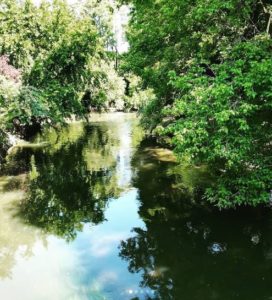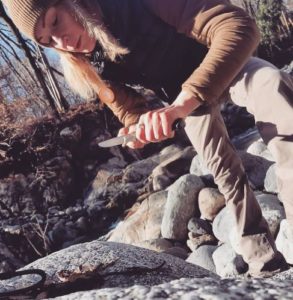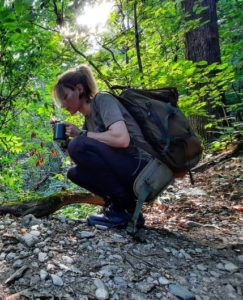Introduction
“When I rest I feel utterly lifeless except that my throat burns when I draw breath… I can scarcely go on. No despair, no happiness, no anxiety. I have not lost the mastery of my feelings, there are actually no more feelings. I consist only of will. After each few metres this too fizzles out in unending tiredness. Then I think nothing. I let myself fall, just lie there. For an indefinite time I remain completely irresolute. Then I make a few steps again.”
― Reinhold Messner
Imagine you are out alone for some pleasant activities in the woods. You have your gear, consisting of a tent or a tarp, survival kit, fire kit, med-kit, cutting tools, navigation devices, sleeping gear. You have plenty of food too.
You spend the first night wrapped into your comfortable sleeping bag, but you reckon you forget your beanie at home. You start to experience some headaches due to the chilling temperatures.

You usually get an aspirin with a lot of water to fix the situation. You definitely hate to feel this way: distraught, with lack of energy and concentration. An aspirin is actually what you need the most to keep enjoying your time outside.
You grab your med-kit but there are no traces of aspirin in it. You forgot to refill it. Your head starts to pulse. You have no chance of resting where you are, abandoning the idea to continue your hike.
You still have hope to find a package of aspirin stuffed somewhere in the truck, but you’re pretty far away from it.
The unexpected increase in headache doesn’t leave you for the entire day. The rest of your adventure is compromised. Or you can still have the chance to save the situation resorting to what you may be able to recognize and to use out from the woods.
Unexpected situations
“[…] Knowledge is not power, it is only potential.
Applying that knowledge is power.
Understanding why and when to apply that knowledge is wisdom.[…]”
When there are no other people within a day’s walk, or when you have no cell connection at all, you have no possibilities to ask for help. Nonetheless, with some knowledge, patience and skills you can still get out of a bad situation in the best way.
Unexpected situations, a minor affliction, in fact, can be faced only if you are capable of getting rid of panic and remaining focused on your previously gained knowledge on what you really need.
No need to say that, if a situation tends to get worse, the most suitable option is to abort your plans and get back to your truck or look for help. In this article we will learn how to find a natural remedy for migrainea and headaches in the woods, starting from salicin and from a particular tree which is high on it: Salix.
Get meds out of the woods
“Any fool can know. The point is to understand.”
― Albert Einstein
The woods can actually provide us all the tools – and remedies – we need to face every potential situation.
 It’s not rocket science. History, in fact, has handed down centuries of studies, researches and examples of how our ancestors were able to take care of themselves and the people in their communities just going outside.
It’s not rocket science. History, in fact, has handed down centuries of studies, researches and examples of how our ancestors were able to take care of themselves and the people in their communities just going outside.
Even if some recent studies enlighten the fact that some plants aren’t 100% safe to use as natural treatment (especially if we abuse of them), the woods can be still considered a huge, and endless (if we pay them respect!) drugstore we can resort to.
As a matter of fact, improvise ourselves herbalists is the worst thing we can do. Reading a book, or watching some videos on YouTube don’t make us experts. As I often do in my articles, let me recommend you once again the importance of attending to some serious classes and workshops run by true professionals.
Some plants and trees are easy to misunderstand. And in some cases you may expect to pay a terrible price in terms of your own safety.
For this reason, the journey in plant identification is long, often uneasy, but very fascinating. The more you learn about the essence of Nature, the more you will discover about her rhythms and benefits. In terms of natural remedies, you will see it as a tremendous benefit.
Some minor diseases, like migraine, can be quickly fixed by knowing the compounds which are contained in the most common meds you usually take.
This is exactly the case with aspirin. Worldwide used – and often abused! – it happens to be one the most popular remedies to face a minor affliction quickly.
But how much do we know about it? Let’s discover more.
How to get aspirin in the woods
“I came to realize that my path to knowledge would not lead me to libraries, professors, universities, and studies. My path to knowledge was through living life and experiencing reality. I could learn plenty secondhand, but nothing was ever to surpass the experiences I had in the wilderness. All my knowledge of social, scientific, and religious issues has been acquired through personal experience.”
― Reinhold Messner
There is one specific tree you need to look for: Willow. It is also known as “osier” and “sallow”. This tree is part of the Salix species, which counts around thirty different spontaneous species. Due to the easiness Salix has to mingle with other plants, a lot of hybrids came to life during all over the centuries. They are around 400 hundred varieties. It usually grows in partially or completely shaded areas, and near streams.
Assyria, Egypt, Sumer ancient texts, in fact, reported the use of willow bark and leaves for different types of aches and fever. In the 5th Century BC, Hippocrates wrote extensively on its medicinal properties.
Native American communities used it as a remedy for temporary pain relief too.
Only in 1763, a French pharmacist named Henri Leroux isolated salicin to crystalline form. 1897: an employer of Bayern AF, Felix Hoffmann, created a new drug out of acetylsalicylic acid. He named it aspirin.
In traditional Chinese medicine and Ayurvedic Medicine willow bark is also employed as a herbal tea, or even as topical ointment. It is known as “liu shu pi”.
Where you can find salicylic acid
“[…] Aspirin is a non-steroidal anti-inflammatory drug (NSAID), which means that it works to decrease inflammation, but is not a steroid. There are other medications that are considered NSAIDs, though these work in a slightly different way from aspirin. The use of aspirin in history goes back to the early 1800s, when a compound in willow bark, termed salicin, was found to reduce pain.[…]” (extract from “Very well health”).
It is believed that all the species related to Salix genus do contain salicin, which is an active extract of the willow bark.
Extensive researches proved that salicin is able to cure many other symptoms like rheumatoid arthritis, low back pain, knee pain, osteoarthritis, and also it can provide some help in weight loss.
How to do it
 In order to get salicin, you should look for shady areas and trees like Weeping willows, purple willows, crack willows, black willows, big-tooth aspens. Go with that only if you are 100% sure about the tree you are going to process.
In order to get salicin, you should look for shady areas and trees like Weeping willows, purple willows, crack willows, black willows, big-tooth aspens. Go with that only if you are 100% sure about the tree you are going to process.
Start scraping the bark and process it into tiny strips. You will be more successful during Spring and Summer. Your goal is to isolate the internal bark, which is what you actually need. By working with a sharp edge of a knife you will make it faster and even more precise.
The next step is to simmer at least two teaspoons you get out of the internal bark and put them in a boiling cup of water. This should require 10 minutes or less. Make it cool before drinking it. If you have no chance in preparing a tea, you can still chew on the bark.
 Actually, there are no guidelines about the appropriate use of willow bark. From a general perspective, an oral dose which consists of 400 mg per day is considered safe, especially to treat joint pain and headaches. Abusing salicin may be extremely dangerous for your health, so be careful not to exceed the proper dosage.
Actually, there are no guidelines about the appropriate use of willow bark. From a general perspective, an oral dose which consists of 400 mg per day is considered safe, especially to treat joint pain and headaches. Abusing salicin may be extremely dangerous for your health, so be careful not to exceed the proper dosage.
Kyt Lyn Walken
Official Representative & Instructor at Hull’s Tracking School
The way of Tracking – European Mantracking School
Certified Wildlife Conservation Ranger at Conservation Ranger Operations Worldwide
Directora de Rastreo Humano por Dynamic Tracking (Spain)
